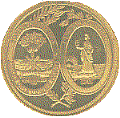SC Seals and Symbols
South Carolina State Seal

On March 26, 1776, the Provincial Congress of South Carolina set up an independent government, electing John Rutledge, President. On April 2, 1776, the President and Privy Council were authorized by Resolution of the General Assembly "to design and cause to be made a Great Seal of South Carolina." Both the arms and reverse symbolize the battle fought on June 28, 1776, between the unnamed, and unfinished fort at Sullivan's Island (now Fort Moultrie), and the British Fleet.
Mace of The House of Representatives

A Mace is the emblem of authority for the House of Representatives. It has been the custom every day, since 1880, upon the opening of session, for the Sergeant-at-Arms to bear the mace ahead of the Speaker and lay it upon it's specially prepared rack on the Rostrum infront of the Speaker. The Mace remains on it's rack until recess or adjournment. When theHouse and Senate meet in a Joint Assembly the Mace is always borne at the head of the procession.
Sword of the Senate

This sword rests in the customary rack on the Senaterostrum in front of the
President's chair during the daily sessions and is carried by the Sergeant-at-Arms on all
State occasions. The present Sword of State was presented to the Senate February 20, 1951,
as apersonal gift to South Carolina by Lord Halifax, former British ambassador to the
United States. The sword was fashioned by master craftsmen of London, England, having a
pointed straight blade, the upper
portion of which is etched with a design containing the State Flower, the yellow
jessamine. One side of the design is centered with the State Seal. It has a golden curved
guard and a handle wrapped with gold braid.